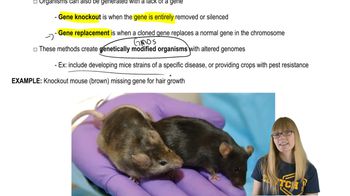True or False:Thymine tautomers can base pair with cytosine.
Table of contents
- 1. Introduction to Genetics51m
- 2. Mendel's Laws of Inheritance3h 37m
- 3. Extensions to Mendelian Inheritance2h 41m
- 4. Genetic Mapping and Linkage2h 28m
- 5. Genetics of Bacteria and Viruses1h 21m
- 6. Chromosomal Variation1h 48m
- 7. DNA and Chromosome Structure56m
- 8. DNA Replication1h 10m
- 9. Mitosis and Meiosis1h 34m
- 10. Transcription1h 0m
- 11. Translation58m
- 12. Gene Regulation in Prokaryotes1h 19m
- 13. Gene Regulation in Eukaryotes44m
- 14. Genetic Control of Development44m
- 15. Genomes and Genomics1h 50m
- 16. Transposable Elements47m
- 17. Mutation, Repair, and Recombination1h 6m
- 18. Molecular Genetic Tools19m
- 19. Cancer Genetics29m
- 20. Quantitative Genetics1h 26m
- 21. Population Genetics50m
- 22. Evolutionary Genetics29m
17. Mutation, Repair, and Recombination
Spontaneous Mutations
Problem 15
Textbook Question
The family of a sixth-grade boy in Palo Alto, California, was informed by school administrators that he would have to transfer out of his middle school because they believed his mutation of the CFTR gene, which does not produce any symptoms associated with cystic fibrosis, posed a risk to other students at the school who have cystic fibrosis. After missing 11 days of school, a settlement was reached to have the boy return to school. What ethical problems might you associate with this example?
 Verified step by step guidance
Verified step by step guidance1
Understand the context: The CFTR gene mutation is associated with cystic fibrosis, a genetic disorder that affects the respiratory and digestive systems. However, not all mutations in the CFTR gene result in symptoms of the disease. In this case, the boy has a mutation that does not produce symptoms, meaning he is not affected by cystic fibrosis.
Identify the ethical issue: The school administrators' decision to transfer the boy was based on the assumption that his genetic mutation posed a risk to other students with cystic fibrosis. This raises ethical concerns about genetic discrimination, as the boy was treated differently based solely on his genetic information, despite not having the disease.
Consider the principle of non-maleficence: This principle in bioethics emphasizes avoiding harm. The decision to exclude the boy from school caused harm to him (e.g., missed education, emotional distress) without clear evidence that his presence posed a risk to others. This violates the principle of non-maleficence.
Examine the principle of justice: Justice in bioethics involves fairness and equal treatment. The boy was treated unfairly based on his genetic information, which is a form of genetic discrimination. This raises questions about the fairness of the school's actions and whether they were justified.
Reflect on the importance of informed decision-making: The school administrators may have acted without fully understanding the science behind the CFTR gene mutation and its implications. Ethical decision-making requires accurate scientific knowledge and consultation with experts to avoid unnecessary harm and discrimination.
 Verified video answer for a similar problem:
Verified video answer for a similar problem:This video solution was recommended by our tutors as helpful for the problem above
Video duration:
54sPlay a video:
Was this helpful?
Key Concepts
Here are the essential concepts you must grasp in order to answer the question correctly.
CFTR Gene and Cystic Fibrosis
The CFTR gene encodes a protein that regulates the movement of salt and water in and out of cells. Mutations in this gene can lead to cystic fibrosis, a serious genetic disorder that affects the lungs and digestive system. Understanding the nature of the specific mutation in the boy's case is crucial, as some mutations may not result in symptoms, raising questions about the implications of labeling individuals based on genetic information.
Recommended video:
Guided course

Transgenic Organisms and Gene Therapy
Ethical Considerations in Genetic Discrimination
Genetic discrimination occurs when individuals are treated unfairly based on their genetic information. In this scenario, the boy's transfer raises ethical concerns about the rights of individuals with genetic mutations, particularly when those mutations do not manifest as health issues. It highlights the tension between public health interests and individual rights, emphasizing the need for careful consideration of how genetic information is used in decision-making.
Recommended video:
Guided course

Descriptive Genetics
Informed Consent and Privacy
Informed consent is a fundamental ethical principle that requires individuals to understand and agree to the use of their personal information, including genetic data. The situation raises questions about whether the school had the right to disclose the boy's genetic status and whether the family was adequately informed about the implications of this information. Protecting privacy and ensuring informed consent are essential in discussions about genetic testing and its consequences.
Recommended video:
Guided course

Genomics Overview
Related Videos
Related Practice
Multiple Choice
509
views
2
rank


